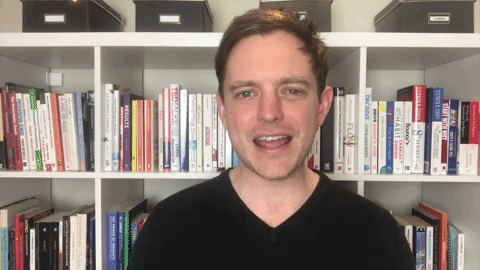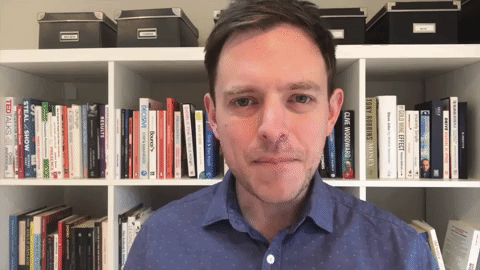In my "Rapid Success" video series I deliver a top communication tip in 90 seconds or less. In this video I give you my top tips on how to use the camera for virtual meetings and webinars…
Why Bother With A Warm-Up?
Use The Power Of The Pause
How To Super Charge Your Performance
Avocados & Cold Showers: Some Lessons In Performance
Who Do You Want To Be?
January is a time when many of us start thinking about what we want from the year ahead of us. What do we want to achieve? Where do we want to go? What do we want to do? The statistics surrounding New Years Resolution’s are diabolical and for most people by the time they read this post many of those plans will have fallen by the wayside. There is lots we could talk about regarding goal setting and habit formation and there is a great body of work around this by people like Tony Robbins and Charles Duhigg. However I wonder if it is more useful to turn our thinking to a more fundamental question. Rather than asking “what do we want to do?”, what would happen if instead we asked ourselves “who do we want to be?”? Instead of planning to run three times a week or make 25 sales calls a day, what if we focused on being a runner or being a sales superstar?
We use identity statements all the time but often without much thought. “I’m a father”. “I’m an HR Business Partner”. “I’m Senior Vice President of Sales EMEA”. They might be useful labels but in reality they don’t tell us much about what the role entails. And therein lies their downfall and at the same time their shining beauty. Used in the right way, these identity statements present a huge opportunity. We get to choose. We get to decide how we play the part. Rather than asking ourselves if we are capable of fulfilling the role, we can start to think about how we are going to fulfil it in our own authentic way.
When I was training to be an actor one of the crucial steps to creating a character was drawing up a list of characteristics. You had to decided what the character was like. Was he brave? Was he smart? Was he naive? These qualities then informed the way in which you played the part. In simple terms, the sort of energy the character approached a situation with was dictated by these characteristics. A confident character enters a room in a very different way to a timid one. When we take time to define our roles, we can choose our characteristic which in turn help to shape our outcomes. You get very different results if you focus on being a committed, powerful and dynamic athlete, rather than just attempting to go to the gym three times a week.
So, instead of writing resolutions this year, I’ve defined the roles I want to play in my business and personal life and for each of those roles I have chosen at least three characteristics. Two weeks into January and I’m making progress in all areas. It’s less about ticking boxes and working to complete isolated activities and more about taking a holistic approach to the sort of person I want to be and the impact I want to have on the world. The roles are helping me to focus my attention and not get distracted by shiny objects and the characteristics are helping me bring the right kind of energy to my activities. The added bonus is that if I miss a workout or succumb to a biscuit with my cup of tea I can look for other ways to fulfil my chosen role rather than beating myself up for falling off the wagon and failing in my chosen task. After all, no matter what role we decide to play, we’re only human and our failures as well as our success are what make us who we are.
Living In The Moment
We moved house this weekend. It’s an event that is generally accepted as being one of the most stressful periods of your life and if our experience can be regarded as typical, there are so many things happening simultaneously that it is sometimes hard to determine whether you are coming or going. As I’m sure my wife will testify I’m pretty meticulous and like to plan things in great detail, so in a high stress situation like moving, my challenge was not to get swept up in the chaos or to place all of my focus on the things that weren’t going to plan – of which there were many!
Now, I’m not going to lie and pretend that I was always a model of cool, calm, collectedness - there was a certain incident involving the garage keys which definitely spiked my blood pressure! – but I was struck by the impact that continually working to remain “in the moment” had on my levels of stress. Rather than focusing on what had or could go wrong, I tried to place my focus on what was happening at the precise moment in time and I was pleasantly surprised by the number of times I felt joy instead of dread.
When I was growing up I vividly remember an elderly friend of the family repeatedly telling us to “enjoy the moment” and at the time I really struggled with the concept. What I think he meant was really try to be present. Take time to notice what is going on around you, to breathe it all in. We live in a world that values and prioritises speed but all too often we fail to connect with the task at hand or the people we are interacting with. We should be human beings but much of the time we are human doings.
The challenge is to continually be in control of your state. To choose the attitude you take into a situation rather than allowing the attitude to choose you. For me that all begins in the body. What we do with our physicality has a massive impact on our mindset so taking a moment or two to stretch, to breathe, to shake things out really allows me to reset my emotional outlook. You can try it right now. As you read these words, take a couple of seconds to notice how you are feeling. What are you doing with your body? Are you holding any tension? What emotions are you experiencing? What thoughts are going through your mind? Now move. Go on! Get out of your chair. Stand up. Stretch. Take a couple of deep breaths. Smile. Feels better doesn’t it?
Making an effort to be mindful, to stay grounded and connected to your objective not only makes you feel better, it makes you more productive too. Rather than flapping around or jumping from one task to the next and back again, being in the moment helps you to move towards your goal one step at a time. It’s not easy but it is effective. During the house move at moments I felt like I was juggling 101 task but when I forced myself to focus on the most important task at hand we seemed to take exponential leaps forward.
So, as you go about your day today take a moment to pause, to notice and to make a choice. How do you choose to be? How would you like to feel? There are no guarantees that everything will go smoothly and according to plan but you’re much more likely to enjoy the journey. As for me, I’m looking forward to getting back from the office, lighting a log fire and soaking in the surroundings of our beautiful new home.
Is it time to ditch digital?
We live in a very connected world. Or so we think… Smart phones and social media have made it easier than ever to grow our networks and broadcast our achievements and yet somehow, amidst all the noise, many people are struggling to make an impact. A quick review of my iPhone apps today revealed that I have 704 Facebook Friends, 1040 Twitter Followers and 1106 LinkedIn Connections. That’s a lot of people and I love the interaction that I have with them. However, as the world becomes more digital it is more important than ever that we can create meaningful human connection and don’t over rely on technology to do the job for us.
If you want to create more impact and have more influence at work try ditching your email and picking up the phone instead. Better yet, walk across the office and speak to colleagues face to face. “Compliance culture” has created the proliferation of massive email chains where people are more interested in covering their backs by documenting their interactions than they are in effectively and efficiently solving the problems at hand. What would happen if you got into the habit of pausing before you hit reply to the latest thing in your inbox? Would a more personal response get you a better outcome? How much time could you save if you cut out the email back-and-forth and discussed the issue instead?
In the moment digital can feel like the easiest and quickest option, yet often it simply delays an inevitable human interaction. To really solve meaningful problems we have to connect, to build trust and develop relationships. Verbal conversations whether on the phone or in person allow us to do this. You can’t fully read body language or decipher tone in an email or an instant message, no matter how many emojis you use!
Yet the solution can’t simply be more face-to-face time. In fact, the research suggests that the average employee spends 31 hours a month in meetings they consider a waste of time! Instead we need to think about the quality of our interactions. Do we have a clear intention for the meeting or call, a tangible objective that we can measure success against? Does everyone present need to be there? Is the agenda clearly defined? Two of the most successful strategies we’ve found for increasing productivity are making meetings shorter – 15 minutes or 45 minutes work well instead of the traditional 30 minutes or an hour – and conducting meetings and conference calls standing up . When people know that time is of the essence and they can’t slump in a comfy chair and zone out, it’s amazing how much more energised and driven people become.
In reality digital is here to stay. Whilst ditching our smartphones might seem appealing, they actually bring us major benefits when used in the right way. The most important thing then is for us to stay in control of our tools rather than allowing our tools to dictate our performance. Being a great communicator is all about self-awareness and being strategic. Instead of reacting immediately to a stimulus, pause and make your response a conscious one. However you choose to respond, the more you truly connect the more effective you’ll become.
The Power Of Intention
In this “Rapid Success” video series I deliver a top communication tip in 90 seconds or less. In this video I discuss the power of intention and why we need to start focusing on how we want our audience to feel.
The Power Of Telling Your Story
Take some time out! The importance of connection.
It’s been a hectic few months. I’m not complaining at all. I’ve had the pleasure of training some amazing delegates and speaking at some brilliant events and now it’s time for a rest. I’m taking next week off and I can’t wait! Of course I’m looking forward to a few lie-ins and the thought of not checking my emails is very appealing but I’m most excited about the extended opportunity to connect – with myself, with my loved ones and with my environment. It might sound a bit fluffy but connection is so important for our wellbeing and happiness and it’s a fundamental ingredient for high performance.
It All Starts With You
It may sound selfish, however, the key to being truly connected is time for yourself. If you’re not in touch with your own sense of purpose, your values and your emotions, then it’s impossible to make anything more than a superficial connection with those around you. If you want to function at a higher level, you have to be in deep connection with the things you are trying to achieve. If what you are doing doesn’t make you want to jump out of bed in the morning, then it’s unlikely that you’ll stick to the plan when temptations or opportunities for procrastination present themselves.
Now don’t get me wrong, you don’t have to love every little task you do, you just have to understand how each step you are taking is part of the overall journey you have chosen to embark on. I spent a good chunk of yesterday going through the business accounts. If I’m honest it’s the part of being an entrepreneur that I enjoy least. However, I know that if I want to succeed in my mission of helping people reconnect with the spoken word, I need to have a viable business that makes money and being on top of the numbers is an essential part of that.
Next week I plan to carve out some quality time each morning to focus on the bigger picture and prepare myself for the exciting challenges that lie ahead. I find that the knock on effect of this is that once I’ve had my “thinking time” I can be much more present and connected with my family. I get to really enjoy the time we spend together without getting distracted by the “work noise” that pops into my head. I’m the first to admit that I often find it difficult to switch off – I love what I do – so working in this way allows me to stay connected to all parts of my life by simply choosing where I place my focus. And I don’t just do this during the holidays. Whenever possible I start the day with planning time and some headspace, so that by the time I reach the office or the training room I am ready to hit the ground running.
There’s Always Time
One of the biggest objections I hear when I talk with people about the importance of connection is “I don’t have time”. We tend to wake up in the morning and get straight on the treadmill of life. We spend our work day moving between meetings, phone calls and emails without taking the time to breathe. Not only do we fail to make time for ourselves, we fail to make time for others too. We tend to see our interactions with colleagues and customers as transactional rather than transformational. When we do this we miss a massive opportunity.
The old adage that time is our only finite resource is often overused. What’s vital to remember though is that we are free to choose how we use it. If you had to find 10 minutes in your day to do something of “life or death” importance, you would. Of course you would also have to let something else slip to do it - that goes without saying. So what we’re really talking about is not a lack of available time but our choice of priorities. What value do you place on connection and what are the benefits of making it non-negotiable? It might be easier to have superficial “yes” or “no” conversations with colleagues and team members but what could be gained by going beneath the surface and working for deeper understanding? Getting out from behind your desk at lunchtime and seeing the world around you will create infinitely more opportunities and spark infinitely more ideas than eating a sandwich at your desk hunched over Facebook. We must take responsibility for creating space in our life. No one else can do it for us.
So, whether you need to focus on connecting with your purpose or connecting with those around you I encourage you to take some time-out this week. Are you sure you don’t have 10 minutes?...
All Change. The time has come for a new style of leadership.
Recent political events in the UK have left the establishment across the globe reeling. What’s next? What will be the impact? Where do we go from here? Whilst the answers to these questions have yet to unfold, what is clear is that traditional methods of leadership aren’t working. This isn’t just a massive problem for the political class. Over the coming weeks and months the pain will be felt by business leaders and managers in every corner of the economy. Whether Brexit will leave Britain better or worse off in the longterm is irrelevant. The only certainty right now is uncertainty. Businesses that embrace the challenge are the ones that will succeed. Leaders who can galvanise their employees around a positive vision for the future and create forward momentum will reap the rewards. The map no longer reflects the territory. The time is ripe for pioneers.
For many people current events have created a generalised feeling of uncertainty and inertia. Motivational leadership is not enough. Rallying cries and calls to action will fall flat. If we want people to come on a journey with us, we need to engage them and help them understand their role. In order to create lasting positive change and unlock the opportunity that a shake up of the status quo undoubtedly creates, we need to step into a phase of “Activational Leadership”. We need to work with our organisations and teams to truly understand the lay of the land from all perspectives and then quickly create a consensus for action. The role of the leader becomes that of the editor-in-chief, sifting through the narrative to distil the best, most compelling story to tell and then presenting it in the most exciting way possible. It is vital that leaders have the ability to ask the important questions and then communicate their findings so that individuals understand their roles clearly and feel compelled to act. As leaders we need to help our people connect to a strong sense of their own identity and then enable them to embody it.
So what do I mean by Activational Leadership? Activational Leadership focuses on moving our followers to action and requires three key skills: the ability to listen, the ability to tell stories and the ability to coach. Combining these three attributes allows leaders and managers to empower employees to take responsibility and most importantly to act.
Top down initiatives in the current climate will, at best, be stalled by a disengaged workforce or, at worst, be rejected outright by people desperate to have their voices heard. If we want to heal division and sooth those in our organisations who feel disengaged or disenfranchised, we have to commit to taking the time to listen deeply. When people feel they have a voice, they feel able to contribute constructively to the conversation – if their audience is listening they don’t need to shout.
The next step for us as leaders is to uncover the story. Facts and figures are not enough to achieve buy-in. We need to paint pictures with words. We need to create opportunities for our employees to associate with the narrative and place themselves at the heart of the action. Storytelling is a shared experience and when the audience is compelled to re-tell or pass the story on, the ultimate form of engagement has been created.
The final step is then to adopt the role of coach and support our employees to create their own victories which will in turn drive the action forward. The ability to communicate in this way is a multiplier and creates leverage. Rather than one person trying to pull or push an organisation into motion, multiple catalysts for change are unlocked. The best coaches will then find ways to harness that energy and channel it to support the narrative.
This shift in leadership style won’t necessarily be easy and will certainly require effort. Whilst not all leaders and managers have these skills today, they can be taught. The companies that succeed will be the ones willing to take risks, adapt and invest in developing their people to rise to the challenge.
















